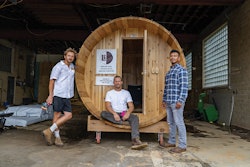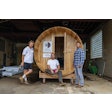
California leads the United States in many areas, including in its share of residential pools. So even pool professionals who don't live or work in California are smart to pay attention to what happens there. New standards for pool pumps and motors sold for use in California are already in effect, with more to take effect in January of 2008. And they may be coming to a jurisdiction near you soon.
The California utility companies figure there are over 1.5 million pool in the Golden State. Unfortunately for those pool owners, California also leads the country in electric rates. Some heavy residential users pay up to 33 cents per kilowatt hour (kwh) to operate air conditioning, pool pumps and the usual electric appliances in a home.
A growing population and surging demand for energy — and soaring prices — convinced electric power providers that conservation was a much better alternative to building more power plants,which can take up to 20 years.
While it might seem counter-intuitive for power companies to encourage their customers to use less power, that's exactly what Pacific Gas & Electric and the other public power utilities in California have been doing.
Who Does What?
The California Energy Commission is charged with writing the standards for energy-consuming products sold in the state, and its rulemaking covers appliances from refrigerated beverage vending machines to air conditioning to hotwater heaters to audio/video equipment and now pool pumps and motors.
There's a perception that regulation means onerous extra work — and cost. But this regulation may actually be a step forward for the industry. Simply put, the regulations are requiring a more-efficient product that will yield higher owner-satisfaction. How often does a pool builder get to offer customers a product that will save them 75 to 90 percent on their utility bills. And because several other states are looking at adopting California's standards, pool professionals across the United States should familiarize themselves with the developments.
Scott Clay, program manager for pools at PG&E, is an energy industry veteran and has been on the leading edge of swimming-pool energy efficiency efforts for the past seven years. PG&E and other power providers started rebate programs to encourage use of more-efficient pumps over five years ago.
"When the utilities decided to give rebates for energy efficient pool pumps in early 2000, there wasn't a large selection of pumps available," says Clay. "Single-speed pumps are the standard, they've been around forever. You get them in two versions; those with energy-efficient motors and those with standard-efficiency motors. The other option was two speed pumps. They had also been around for a long time and used predominantly in spas — low speed to circulate, high speed to run the jets.
"But they weren't really used or accepted for pool use because no one understood the need to pump the water slower.
"We ran a pilot program in the last quarter of 2000 that just gives rebates for two-speed pumps. And we got a fairly good response, enough to justify running a full-scale program in 2001. Unfortunately, the other utilities were a little hesitant to go to all two-speeds, so we agreed on rebates for single speed with an energyefficient motor and reduced horsepower."
Two-Speed Evangelists
Clay and his colleagues were convinced of the energy savings to be had from the two-speed pumps, and launched an education program aimed at both the pool contractors and the customers. "We developed a six-hour class that we teach monthly at various locations throughout our service territory, and we've been doing that for five years. The class is called 'Pool Filtration At Half The Cost.'"
In late 2004, Clay began hearing about variable-speed technology for pool pumps, and his ears really perked up. "The contractors hadn't heard about them, and they'd see it during our demonstrations. We were able to tell them how much energy could be saved. So we promoted what we call now multi-speed technology — which includes the two-speed and the four-speed they have now and the variable speed."
And there's a good reason that Clay in his colleagues were excited with the technology. "You can cut the electrical consumption for filtering a pool by as much as 75 percent by using a variable-speed pump," he says. "That assumes that for most of the pumping you use the lowest speed you can use on your pool."
Sudden Impact
The savings potential of multi-speed technology is impressive. In the PG&E territory, pool pumps are the single largest consumer of residential electricity. "At last count there were about 1.5 million pools in California. If you take the average use per pool, it adds up to about seven good-sized power plants," says Clay. "In our service territory, it's about 5 percent from just pool pumps. HVAC is up there, but nothing else is even close. And air conditioning is in a lot more homes than are pools, and the AC runs much longer.
"We figure that, if everyone switched to multi-speed motors, we could get by with about a third of those seven power plants."
Even with those exciting numbers, committees move slowly. The utility companies had a hard time convincing the Public Utilities Commission (which releases funds for rebate programs). "We told them about the rebate program and what we considered a huge impact," says Clay. "The response was, 'That's a luxury item, and we want to give rebate money to the mass public.' They finally realized that even though it hits a lot less people, the fact is those people are drawing a disproportionate share of energy?
So instead of trying to penalize them because they have a pool, why don't we encourage them through rebates to make a change so they don't have to use so much energy."
What's It To You.
Eventually the CEC, with input from the utilities and the industry, developed a standard that will be implemented in phases. Clay says the first step is to collect performance data from all the manufacturers in order to determine reasonable minimum requirements. In the meantime, they did know that some electric motors are more efficient than others. "Second, after January 2006, California allows only capacitor start/capacitor run motors and split capacitor motors. So since we didn't know the efficiency numbers, we drew the line on the types of motors that are more efficient than others," he says.
The third step is labeling. With no standards in place, manufacturers were free to label their pumps in whatever way made sense to them. "The pumps and the motors were just so poorly labeled you couldn't tell what you were buying," he says.
It was difficult to know if a given pump qualified for a rebate. "If you wanted to buy a new single-speed pump, the requirement was that you had to reduce the horsepower by a half a horsepower. So if you had a 2 horsepower in the past and you bought a new horse-and-a-half pump, you'd be eligible for the rebate.
"The problem is that the industry uses a service factor on the motor. And that has to be factored in to determine the actual amount of energy that motor is going to use. So for example, a 1-horsepower pump that has a service factor of 1.65, when you multiply it out actually has a total horsepower of 1.65," says Clay. So in that example, the pump wouldn't qualify for the rebate.
"Then, what really drives the amount of horsepower is the pump itself, the pump impeller. One manufacturer would put large impeller in and use motors that are labeled smaller, but have huge service factors." Clay says the most extreme example was a 0.75 motor with a 2.1 service factor. It was essentially a 1.5 horsepower motor, but it was labeled as a 0.75 horsepower pump.
"So this kind of labeling gets everybody confused," says Clay.
The new standards in California require a label on the pump itself and on the motor showing horsepower and service factor.
On Deck
After Jan. 1, 2008, pool filtration pumps of 1 horsepower or greater sold in California must have 2 or more speeds. "The early adopters right now are jumping on variablespeed products," says Clay.
One more benefit of multi-speed pumps: "Energy-efficiency programs are in direct alignment with any kind of greenhouse-gas-reduction legislation. Maybe sometimes it not clear to the end user right away, but when you start talking about eliminating the use of three or four power plants, then it becomes a little clearer."
How Do They Do That?
"You can cut the electrical consumption for filtering a pool by as much as 75 percent by using a variable-speed pump. What that assumes is that you only use the higher speeds when you need to, and for most of the pumping, which is for filtration, you use the lowest speed you can use on your pool.
"What the variable speed has over the two-speed is that you're not set at just two RPMs on the motor. On a two-speed pump, you have the high setting, which is turning at 3,450 RPM. On the low speed of a two-speed, they are all set at 1,725, which is exactly half.
"The pump affinity law says that when you drop the motor speed in half, you only have the square of the difference in the speeds, so 1/2 x 1/2 is 1/4. One quarter of the pressure in the system. So if you were pumping against 60 feet of head in a typical poool, when you drop to low speed, you're only pumping against 15 feet of head. Which means your motor isn't working as hard.
"For that reason, the amount of power that that motor draws is the cube of the difference. So 1/2 x 1/2 x 1/2 equals only 1/8 of the energy. As it works out, since you're only getting half the flow when you go to half speed, you have to pump twice as long on low speed, so essentially you only use 1/4 of the energy. Now that's theoretical. In practice what we see in a moderate head system, somewhere around 1/5 or 1/6 of the energy.
"So the way it works with the variable speed is you don't have to choose a speed that's as high as a two-speed, you can set the system to use just enough energy to get the work done."
Scott Clay is the program manager for pools at Pacific Gas & Electric.










































